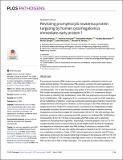Files in this item
Revisiting promyelocytic leukemia protein targeting by human cytomegalovirus immediate-early protein 1
Item metadata
| dc.contributor.author | Paulus, Christina | |
| dc.contributor.author | Harwardt, Thomas | |
| dc.contributor.author | Walter, Bernadette | |
| dc.contributor.author | Marxreiter, Andrea | |
| dc.contributor.author | Zenger, Marion | |
| dc.contributor.author | Reuschel, Edith | |
| dc.contributor.author | Nevels, Michael Martin | |
| dc.date.accessioned | 2020-05-20T15:30:05Z | |
| dc.date.available | 2020-05-20T15:30:05Z | |
| dc.date.issued | 2020-05-04 | |
| dc.identifier | 268046335 | |
| dc.identifier | b352ab1a-0c49-4bf3-8a32-7c27f3e6e2e5 | |
| dc.identifier | 000538054300011 | |
| dc.identifier | 85086913007 | |
| dc.identifier.citation | Paulus , C , Harwardt , T , Walter , B , Marxreiter , A , Zenger , M , Reuschel , E & Nevels , M M 2020 , ' Revisiting promyelocytic leukemia protein targeting by human cytomegalovirus immediate-early protein 1 ' , PLoS Pathogens , vol. 16 , no. 5 , e1008537 . https://doi.org/10.1371/journal.ppat.1008537 | en |
| dc.identifier.issn | 1553-7366 | |
| dc.identifier.other | ORCID: /0000-0002-7115-407X/work/74510304 | |
| dc.identifier.other | ORCID: /0000-0002-4123-5629/work/74510332 | |
| dc.identifier.uri | https://hdl.handle.net/10023/19974 | |
| dc.description | This work was supported by a grant (MR/P022146/1) from the Medical Research Council (https://mrc.ukri.org) to MMN, a grant (T16/28) from Tenovus Scotland (https://tenovus-scotland.org.uk) to CP, a European Union Erasmus+ grant (https://www.erasmusplus.org.uk) to BW and the Wellcome Trust Institutional Strategic Support Fund (https://wellcome.ac.uk) to CP and MMN. | en |
| dc.description.abstract | Promyelocytic leukemia (PML) bodies are nuclear organelles implicated in intrinsic and innate antiviral defense. The eponymous PML proteins, central to the self-organization of PML bodies, and other restriction factors found in these organelles are common targets of viral antagonism. The 72-kDa immediate-early protein 1 (IE1) is the principal antagonist of PML bodies encoded by the human cytomegalovirus (hCMV). IE1 is believed to disrupt PML bodies by inhibiting PML SUMOylation, while PML was proposed to act as an E3 ligase for IE1 SUMOylation. PML targeting by IE1 is considered to be crucial for hCMV replication at low multiplicities of infection, in part via counteracting antiviral gene induction linked to the cellular interferon (IFN) response. However, current concepts of IE1-PML interaction are largely derived from mutant IE1 proteins known or predicted to be metabolically unstable and globally misfolded. We performed systematic clustered charge-to-alanine scanning mutagenesis and identified a stable IE1 mutant protein (IE1cc172-176) with wild-type characteristics except for neither interacting with PML proteins nor inhibiting PML SUMOylation. Consequently, IE1cc172-176 does not associate with PML bodies and is selectively impaired for disrupting these organelles. Surprisingly, functional analysis of IE1cc172-176 revealed that the protein is hypermodified by mixed SUMO chains and that IE1 SUMOylation depends on nucleosome rather than PML binding. Furthermore, a mutant hCMV expressing IE1cc172-176 was only slightly attenuated compared to an IE1-null virus even at low multiplicities of infection. Finally, hCMV-induced expression of cytokine and IFN-stimulated genes turned out to be reduced rather than increased in the presence of IE1cc172-176 relative to wild-type IE1. Our findings challenge present views on the relationship of IE1 with PML and the role of PML in hCMV replication. This study also provides initial evidence for the idea that disruption of PML bodies upon viral infection is linked to activation rather than inhibition of innate immunity. | |
| dc.format.extent | 40 | |
| dc.format.extent | 8650262 | |
| dc.language.iso | eng | |
| dc.relation.ispartof | PLoS Pathogens | en |
| dc.subject | QH301 Biology | en |
| dc.subject | QR Microbiology | en |
| dc.subject | DAS | en |
| dc.subject.lcc | QH301 | en |
| dc.subject.lcc | QR | en |
| dc.title | Revisiting promyelocytic leukemia protein targeting by human cytomegalovirus immediate-early protein 1 | en |
| dc.type | Journal article | en |
| dc.contributor.sponsor | Medical Research Council | en |
| dc.contributor.sponsor | The Wellcome Trust | en |
| dc.contributor.institution | University of St Andrews. Biomedical Sciences Research Complex | en |
| dc.contributor.institution | University of St Andrews. School of Biology | en |
| dc.identifier.doi | 10.1371/journal.ppat.1008537 | |
| dc.description.status | Peer reviewed | en |
| dc.identifier.grantnumber | MR/P022146/1 | en |
| dc.identifier.grantnumber | en |
This item appears in the following Collection(s)
Items in the St Andrews Research Repository are protected by copyright, with all rights reserved, unless otherwise indicated.

